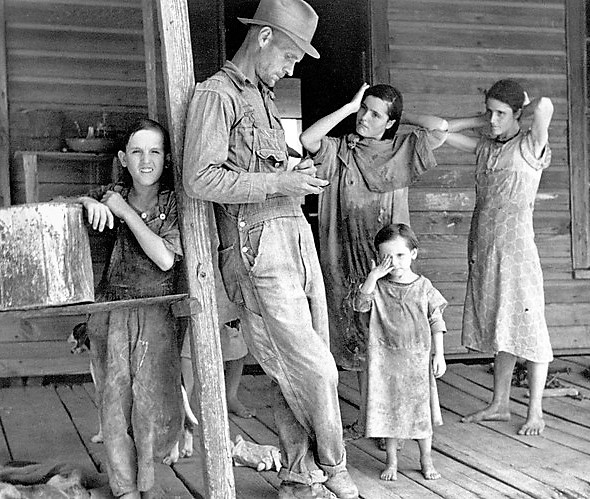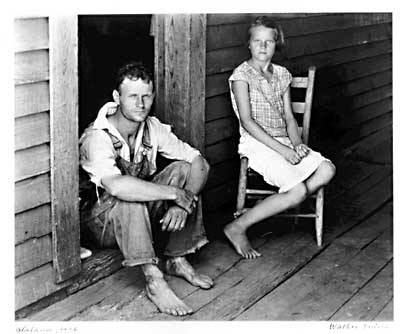Walker Evans – ‘Let Us Now Praise Famous Men’:
Walker Evans is an American photograph, who influenced the evolution of ambitious photography during the later 20th century. His imagery looks at creating a poetic resonance, which describe the subject presented within the photograph. He is said to be the first photographer to produce a photo book to present his photographic responses, entitled ‘American Photographs’. His work challenges social issues, through the style of documentary photography, this element is clearly shown within his photographic series ‘ Let Us Now Praise Famous Men’.
Mood Board showcasing Walker Evans’ imagery from his photographic series ‘Let Us Now Praise Famous Men’
Conceptual and Contextual:
Let Us Now Praise Famous Men, is one of Walker’s most known photographic series which was started in 1936, captured imagery for 5 years, and the photo book being published in 1941, in which he teamed up with American author James Agee to create an embodiment of work which documents the lifestyle of Tenant Farmers in Alabama during the Depression era. For contextual reference a tenant farming is a form of agriculture, in which a land owner with contribute their land on measure of operating capital and work, while the tenants contributes their labour, with the return being given in a variety of ways. The return can be, a share in the produce, cash or a combination of both. This is only said to be 5% of the agriculture, making these subjects a minority in society and within the industry, thus create more captivating imagery showcasing their lifestyle. Sadly, this form of work can lead to abuse when the landowner has to much power, or inferior social status. Initially, the project was to capture white cotton farmers in South America, but the focus soon changed after a lack of subjects being found, the new idea of tenant farmers formed after the two lived with three tenant family farmers. The families lived with no electricity or running water, and have lived this life style since their childhood.
“Let Us Now Praise Famous Men harkens back to a time when millions of Americans lived a truly subsistence existence, and their families were the one buttress against an eternal winter of silent despondency.” (Ingram.B, 2014) In a review article which analyses the book written by James Agee, with comments on Evans photographer, the author wrote about how the imagery Evan produces allows the clear narrative to tell the story of the lives of the three tenant farmer families. “Evans was a preeminent photographer of his time, and his almost stark work here is the perfect foil for Agee’s” (Ingram.B, 2014). Evans’ photographs within this book has pleased many critics as the images illustrates the imagery created by the word produced by Agee.
In another article, published by the Guardian, the author describes Evan’s imagery to present reality, “You can’t sniff the stink of the quilts in the Evans pictures, nor itch with the lice in the pillows. The foul beds take on a Shaker dignity of form. A gasoline pump on the porch of a post office metamorphoses into sculptural permanence within the fixed focal length of Evans’s lens.” (Rule.V, 2001). His positive critique to Evans’ imagery emphasises how accurately he managed to capture the raw living environments of the tenant families, which allows viewers to sympathises for these families, as we understand that they do not know life any differently. As previously mentioned it allows our imagination from the novel, written by Agee, to visually see and understand this reality, making the stories more real and empowering. The author also mentions how Evan’s photographs “beatifies, the bemused children of poverty more than any adjective or adverb Agee might edit out of his copy.” (Rule.V, 2001). This illustrates how the images within the photographic novel holds stronger representation of the lives of the tenants than the story itself, as words are not powerful enough to describe these conditions. In addition, he is referring to the idea that the images are being beatified, which informs us that the photographs are captivating and have the authenticity which makes the images seem beautiful, which juxtaposes the negative connotations the images actually hold.
Technical and Visual:
The double page spread presented below is one of the most famous page spreads form any of his photographic books, and is taken from his series ‘Let Us Now Praise Famous Men’. I believed that these two images held a lot of visual and technical value which allow me to critically analyse Evan’s work in order for me to describe the way in which his conceptual representations is presented.

Walker Evans – Let Us Now Praise Famous Men
Visually, the two documentary style portraits are minimalistic, in the sense that the frame has a lot of space, which depicts the conceptual representation of their basic and hard lifestyle they live, and shows how they have nothing. The photographs are two headshots taken at a straight on angle of a male and a female, to which I believe are husband and wife, which are the main focal points of the image. The clothing they are wearing suggests a lot about their low social status, their shirts seemed creased, and through the image being in black and white and high tonal contrast, we can see how soiled these subjects are. Their facial expressions are neutral, but their strong eye contact towards the lens almost suggests they are asking for help, and illustrates their pain and suffering. The background of the images are just their natural environment, which seems to be a wall or apart of their small wooden cottages. With regards to the formal elements, texture, space, tone and form, help to illuminate their poor living conditions, and adds to the authenticity of the naturalistic imagery, creating sympathy for viewers.
Technically, the photographs use basic camera settings, which shows how the time period of the photographs being taken, 1936, has influenced the outcomes. It is suggested that naturalistic lighting has been used to capture these outcomes, which means a daylight white balance would have been used, which juxtaposes the cold ambiance the images hold, also emphasising the pejorative connotations towards this imagery. The photographs have a grainy look, which shows the contextual element of the time period and could suggest how a high ISO was used in order to capture the images. In addition to this a quick shutter speed was likely to be used, as well as a medium aperture due to a slight depth of field being used and the imagery being having a darker tone towards it and the subject being in clear focus and sharp.
Action Plan:
Moving forward I intend to conduct a new photo shoot which looks at capturing the lives and lifestyle of my grandparents, and try and illustrate how the working lives have resulted in the lives at present. I intend to capture imagery outside, as that is mainly were Evan’s images were taken, which allows me to explore the relationship between my Grandparents and their exterior of their house. In addition, I look to create a selection of portraits which express this conceptual representation, through the images being in black and white, high tonal contrast and strong connection with the camera lens.
Bibliography:
Ingram, B. (2014). ‘Let Us Now Praise Famous Men’ by James Agee and Walker Evans. [online] Broadstreetreview.com. Available at: https://www.broadstreetreview.com/books/let-us-now-praise-famous-men-by-james-agee-and-walker-evans# [Accessed 15 Jan. 2020].
Rule, V. (2001). Review: Let Us Now Praise Famous Men by James Agee and Walker Evans. [online] the Guardian. Available at: https://www.theguardian.com/books/2001/aug/18/historybooks.highereducation [Accessed 15 Jan. 2020].








